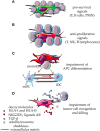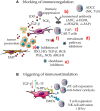How to Hit Mesenchymal Stromal Cells and Make the Tumor Microenvironment Immunostimulant Rather Than Immunosuppressive
- PMID: 29515580
- PMCID: PMC5825917
- DOI: 10.3389/fimmu.2018.00262
How to Hit Mesenchymal Stromal Cells and Make the Tumor Microenvironment Immunostimulant Rather Than Immunosuppressive
Erratum in
-
Corrigendum: How to Hit Mesenchymal Stromal Cells and Make the Tumor Microenvironment Immunostimulant Rather Than Immunosuppressive.Front Immunol. 2018 Jun 11;9:1342. doi: 10.3389/fimmu.2018.01342. eCollection 2018. Front Immunol. 2018. PMID: 29923549 Free PMC article.
Abstract
Experimental evidence indicates that mesenchymal stromal cells (MSCs) may regulate tumor microenvironment (TME). It is conceivable that the interaction with MSC can influence neoplastic cell functional behavior, remodeling TME and generating a tumor cell niche that supports tissue neovascularization, tumor invasion and metastasization. In addition, MSC can release transforming growth factor-beta that is involved in the epithelial-mesenchymal transition of carcinoma cells; this transition is essential to give rise to aggressive tumor cells and favor cancer progression. Also, MSC can both affect the anti-tumor immune response and limit drug availability surrounding tumor cells, thus creating a sort of barrier. This mechanism, in principle, should limit tumor expansion but, on the contrary, often leads to the impairment of the immune system-mediated recognition of tumor cells. Furthermore, the cross-talk between MSC and anti-tumor lymphocytes of the innate and adaptive arms of the immune system strongly drives TME to become immunosuppressive. Indeed, MSC can trigger the generation of several types of regulatory cells which block immune response and eventually impair the elimination of tumor cells. Based on these considerations, it should be possible to favor the anti-tumor immune response acting on TME. First, we will review the molecular mechanisms involved in MSC-mediated regulation of immune response. Second, we will focus on the experimental data supporting that it is possible to convert TME from immunosuppressive to immunostimulant, specifically targeting MSC.
Keywords: carcinoma-associated fibroblast; immunosuppression; mesenchymal stromal cells; tumor microenvironment; tumor-associated fibroblast.
Figures



Similar articles
-
Mechanisms of tumor escape from immune system: role of mesenchymal stromal cells.Immunol Lett. 2014 May-Jun;159(1-2):55-72. doi: 10.1016/j.imlet.2014.03.001. Epub 2014 Mar 20. Immunol Lett. 2014. PMID: 24657523 Review.
-
Effect of mesenchymal stem cells-derived exosomes on tumor microenvironment: Tumor progression versus tumor suppression.J Cell Physiol. 2019 Apr;234(4):3394-3409. doi: 10.1002/jcp.27326. Epub 2018 Oct 26. J Cell Physiol. 2019. PMID: 30362503 Review.
-
Mesenchymal stromal cells (MSCs) and colorectal cancer: a troublesome twosome for the anti-tumour immune response?Oncotarget. 2016 Sep 13;7(37):60752-60774. doi: 10.18632/oncotarget.11354. Oncotarget. 2016. PMID: 27542276 Free PMC article. Review.
-
Mesenchymal Stromal Cells Can Regulate the Immune Response in the Tumor Microenvironment.Vaccines (Basel). 2016 Nov 8;4(4):41. doi: 10.3390/vaccines4040041. Vaccines (Basel). 2016. PMID: 27834810 Free PMC article. Review.
-
Exosome and mesenchymal stem cell cross-talk in the tumor microenvironment.Semin Immunol. 2018 Feb;35:69-79. doi: 10.1016/j.smim.2017.12.003. Epub 2017 Dec 27. Semin Immunol. 2018. PMID: 29289420 Free PMC article. Review.
Cited by
-
Integrated analysis of 1804 samples of six centers to construct and validate a robust immune-related prognostic signature associated with stromal cell abundance in tumor microenvironment for gastric cancer.World J Surg Oncol. 2022 Jan 5;20(1):4. doi: 10.1186/s12957-021-02485-y. World J Surg Oncol. 2022. PMID: 34983559 Free PMC article.
-
New perspective into mesenchymal stem cells: Molecular mechanisms regulating osteosarcoma.J Bone Oncol. 2021 Jun 23;29:100372. doi: 10.1016/j.jbo.2021.100372. eCollection 2021 Aug. J Bone Oncol. 2021. PMID: 34258182 Free PMC article. Review.
-
Menstrual blood-derived endometrial stem cell, a unique and promising alternative in the stem cell-based therapy for chemotherapy-induced premature ovarian insufficiency.Stem Cell Res Ther. 2023 Nov 13;14(1):327. doi: 10.1186/s13287-023-03551-w. Stem Cell Res Ther. 2023. PMID: 37957675 Free PMC article. Review.
-
Hypoxia and interleukin-1-primed mesenchymal stem/stromal cells as novel therapy for stroke.Hum Cell. 2024 Jan;37(1):154-166. doi: 10.1007/s13577-023-00997-1. Epub 2023 Nov 21. Hum Cell. 2024. PMID: 37987924 Free PMC article. Review.
-
Influence of Indoleamine-2,3-Dioxygenase and Its Metabolite Kynurenine on γδ T Cell Cytotoxicity against Ductal Pancreatic Adenocarcinoma Cells.Cells. 2020 May 6;9(5):1140. doi: 10.3390/cells9051140. Cells. 2020. PMID: 32384638 Free PMC article.
References
Publication types
MeSH terms
Substances
LinkOut - more resources
Full Text Sources
Other Literature Sources
Medical
Molecular Biology Databases

